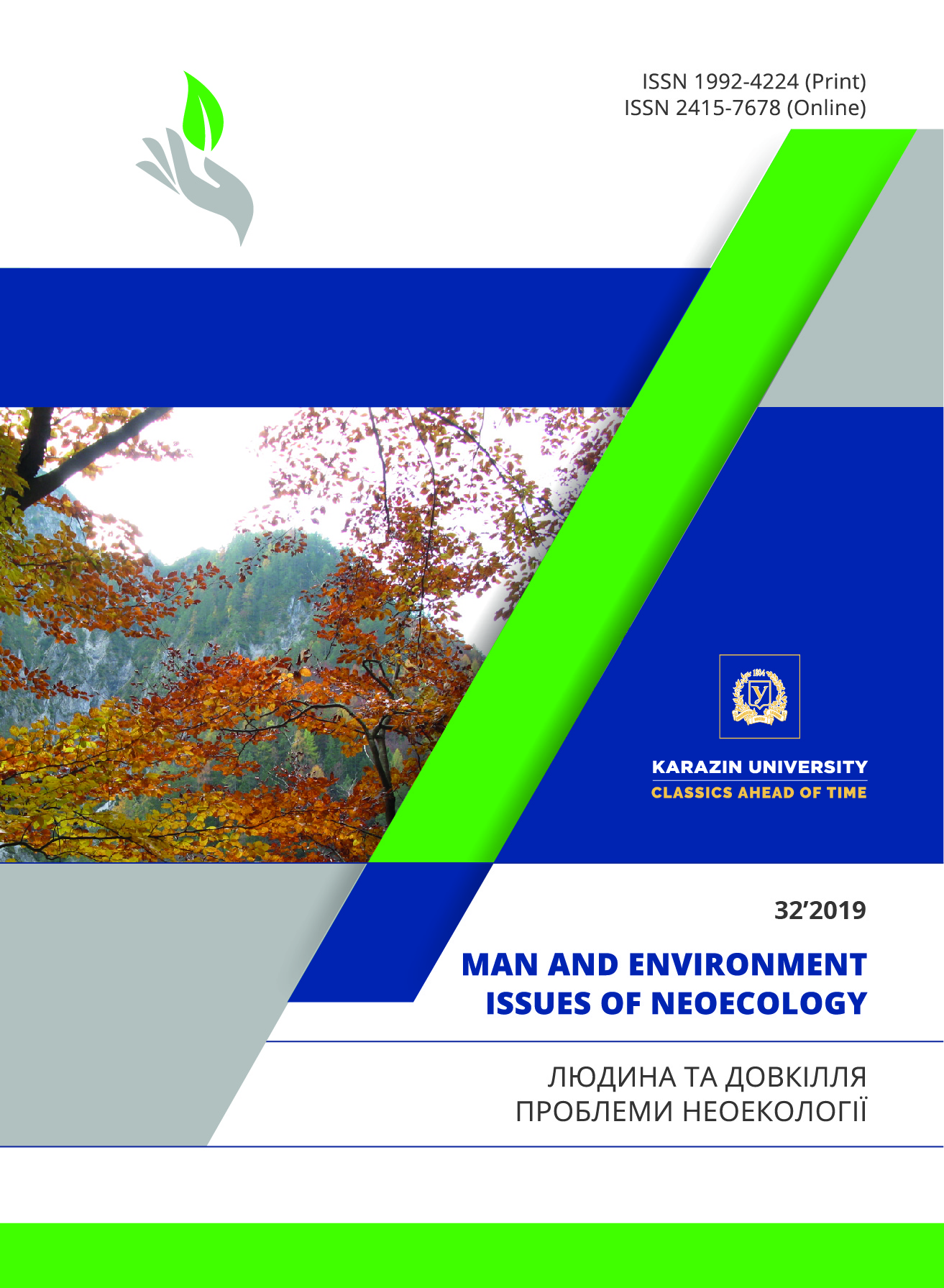Водойми міста Львова: сучасний геоекологічний стан та можливості його покращення
Анотація
Мета. Характеристика геоекологічного стану водойм у місті Львові для розробки рекомендацій щодо охорони, збереження та підвищення їх функціонального використання.
Методи. Польові, картографічні, історичні, аналіз та синтез.
Результати. За даними фондових, статистичних матеріалів проведений аналіз забруднення води репрезентативних водойм. Під час польових досліджень здійснений аналіз фізичних параметрів стану води, виявлені джерела забруднення водойм, засмічення та загальна оцінка прибережних водозахисних смуг. Для більшості водойм Львова характерні засмічення прибережної природоохоронної смуги, рекреаційний вплив, близькість до автомобільних доріг та житлових будинків. Колір води у переважній кількості водойм сірувато-жовтуватий, прозорість води низька, запах болотистий або землянисто-трав’янистий. Десять з двадцяти трьох досліджуваних водойм мають сильну і надсильну евтрофікацію. Влітку деякі повністю заростають водоростями. Стан улоговини у 70% водойм Львова природний. Це сприяє додатковому надходженню у воду забруднюючих речовин з водозбірного басейну. Стави, де улоговина вкрита штучним покриттям (переважно бетоном) мають кращі якісні показники води. Зокрема став Левандівський, єдиний на початок 2019 р., має чисту воду. Останні роки водойми міста значно обміліли, через забудову водозбірних басейнів та відведення дощових вод у загальну каналізацію. У найкращому стані знаходяться водойми поблизу ресторанів та закладів відпочинку, що здані в оренду. Задовільний геоекологічний стан у ставків, що знаходяться у паркових зонах (у парках Стрийському, Погулянка, Шевченківський гай, Піскові озера). Найбільше занедбаними є водоймами колишніх промислових підприємств, якими опікуються районні адміністрації.
Висновки. Нераціональне використання водойм міста призводить до забруднення води; замулення і заростання мілких водойм; пришвидшеної евтрофікації, засмічення тощо. Враховуючи поліфункціональне значення водойм для міста, розроблені рекомендації щодо покращення їх геоекологічного стану, переважно це організаційні (моніторинг стану водойм, ведення екологічного паспорту водойми, підвищення контролю), технічні (роз’єднання дощової та комунальної каналізації, технічний догляд), просвітницькі (стенди, екоакції, фестивалі) заходи.
Завантаження
Посилання
Water Code of Ukraine from 06.06.1995 with changes from 21.09.2000, 7.12.2000, 12.12.2001. Chapter I, Chapter 1, Art. 1. (1995). Available at: https://zakon1.rada.gov.ua › laws (In Ukrainian).
Voloshyn, I., & Sobechko, O., (2013). Acid precipitation of the city of Lviv: their chemistry, metallization of natural components: monograph. Lviv, Ukraine : LDUFK. (In Ukrainian).
Voloshyn, I., Kremin, N., & Knysh, I., (2018). Limnological attractions of southwestern Lviv. Geotourism: practice and experience, 3rd International Scientific and Practical Conference 2018. Lviv, Ukraine: Kame-niar . 57-58. (In Ukrainian).
Hrytsyniak, I. I., & Kolesnyk, N. L., (2016). A significant contribution to the study of the ecological status of urban reservoirs. Fisheries Science of Ukraine 2, 132-134. (In Ukrainian).
Hural, R.I. (2012). Pollution of water biotopes of city Lviv an ditvicinitybyions of heavy metals. Scientific notes of the State Museum of Natural History, (28), 69-76. (In Ukrainian).
State Water Cadastre: A record of surface water bodies. (2018). Geoportal «Water Resources of Ukraine». (n.d.). Available at: http://map.davr.gov.ua:44481/#waterPolygonSidebar (date of appeal 02.03.2018). (In Ukrainian).
Dumych, O., Danylyk, I., &Suvadlo, I., (2019). Zooplanktofauna of the lake in park «Gorihovij Gaj». Current state and prospects of development of landscape architecture, gardening economy, urban ecology and phytomelioration, International scientific-practical conference. Lviv, Ukraine: NLTU. 228-230. (In Ukrainian).
Koinova, I., &Chorna, A-K., (2018). Lviv reservoirs: importance for the functioning of the city. Natural Re-sources of the Region: Problems of Use, Revitalization and Conservation: 3rd International Scientific Semi-nar. Lviv. 185-190. (In Ukrainian).
Koinova, I., Rozhko, I., & Chorna, A-K., (2019). Possibilities of recreational use of the reservoirs of Lviv. Ge-ography, Economics and Tourism: National and International Experience, 13th International Scientific Conference . Lviv. 273-276. (In Ukrainian).
Syrko, N., & Mykitchak, T., (2010). Fauna of plankton branched and octopus crustaceans of some reservoirs of Lviv. Scientific Basics of Biodiversity Conservation,10th Scientific Conference of Young Scientists. Lviv. 18-20. (In Ukrainian).
State of the environment in Lviv region. Information-analytical review. I quarter of 2018. (2018). deplv.gov.ua. Available at: https://drive.google.com/file/d/1513oFqctiWQcGaDWc0xtLBN1IjMJsjRS/view (In Ukrainian).
State of the environment in Lviv region. Information-analytical review. I quarter of 2019. (2019). deplv.gov.ua. Available at: https://drive.google.com/file/d/1wjQn1Hxcc44jd2Rke1MkTKSWLtbPiQhz/view (In Ukrainian).
Chorna, A-K., (2018). Pollution of the reservoirs of Lviv. Realities, problems and prospects of development of geography in Ukraine: 19th student scientific conference. Lviv: Ivan Franko Publishing Center. 130-137 (In Ukrainian).
Voloshyn, I., Vovkanych, L., & Halasa, O., (2001). Urban waters and assessment of their ecological status. Man and environment. Issues of neoecology, (2), 157-162. (In Ukrainian).
Shushniak, V., Savka, H., & Verheles, Yu., (2014). Results of the inventory of water bodies of the city of Lviv. Bulletin of the University of Lviv. The series is geographical, (48), 322-327. (In Ukrainian).
Автори, які публікуються у цьому журналі, погоджуються з наступними умовами:
- Автори залишають за собою право на авторство своєї роботи та передають журналу право першої публікації цієї роботи на умовах ліцензії Creative Commons Attribution License 4.0 International (CC BY 4.0), котра дозволяє іншим особам вільно розповсюджувати опубліковану роботу з обов'язковим посиланням на авторів оригінальної роботи та першу публікацію роботи у цьому журналі.
- Автори мають право укладати самостійні додаткові угоди щодо неексклюзивного розповсюдження роботи у тому вигляді, в якому вона була опублікована цим журналом (наприклад, розміщувати роботу в електронному сховищі установи або публікувати у складі монографії), за умови збереження посилання на першу публікацію роботи у цьому журналі.
- Політика журналу дозволяє і заохочує розміщення авторами в мережі Інтернет (наприклад, у сховищах установ або на особистих веб-сайтах) рукопису роботи, як до подання цього рукопису до редакції, так і під час його редакційного опрацювання, оскільки це сприяє виникненню продуктивної наукової дискусії та позитивно позначається на оперативності та динаміці цитування опублікованої роботи (див. The Effect of Open Access).





